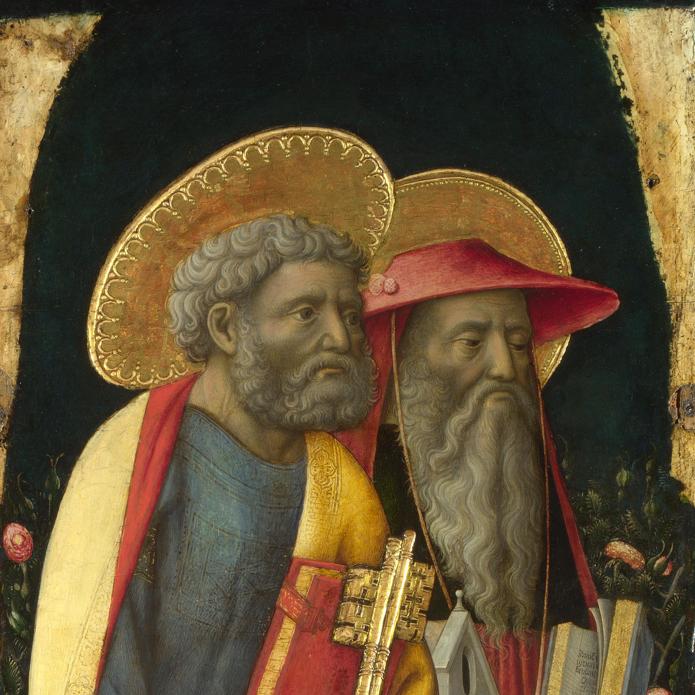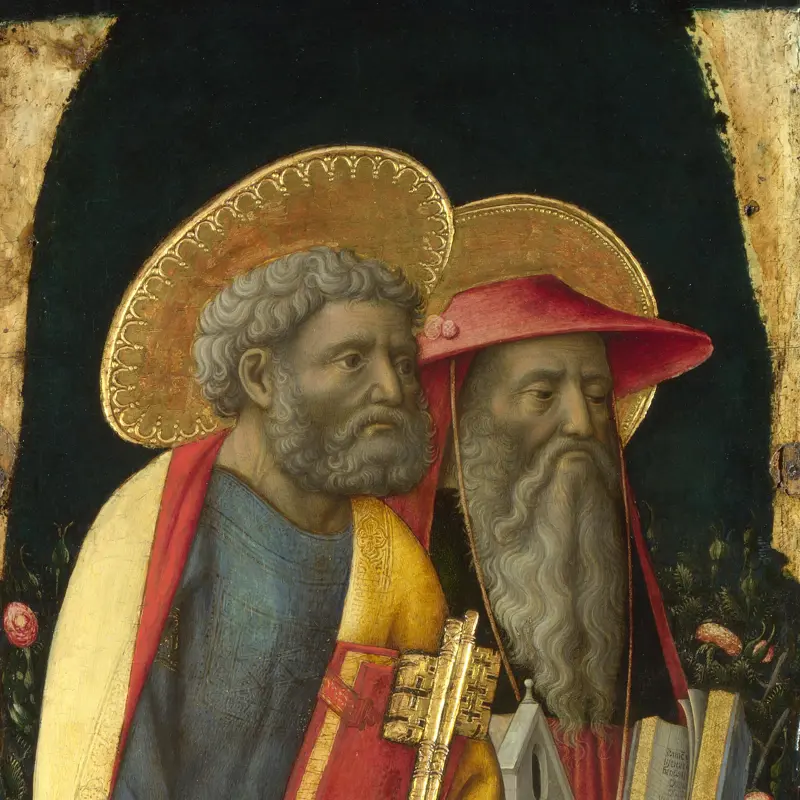Antonio Vivarini and Giovanni d'Alemagna, 'Saints Francis and Mark', about 1440-6
About the work
Overview
Two saints stand on a fantastically cusped stone plinth in front of a rose hedge. They are Francis and Mark, identified by their attributes – the symbols with which they are traditionally associated – and by the inscriptions in the front of the plinth. Mark, one of the four authors of the Gospels, holds a copy of his Gospel, while Francis is dressed in a brown habit and holds a crucifix.
They were once the right wing of a triptych (an altarpiece in three parts) painted in Venice in the 1440s by Antonio Vivarini and his brother-in-law and partner Giovanni d'Alemagna.
The altarpiece originally stood in the church of Saint Moisé in Venice, and the saints on it would have been chosen by its patrons. Saint Mark was the patron saint of Venice; Saint Francis, founder of the Franciscan Order, was hugely popular in the fifteenth century.
Key facts
Details
- Full title
- Saints Francis and Mark
- Artist
- Antonio Vivarini and Giovanni d'Alemagna
- Artist dates
- probably active 1440; died 1476/84; died 1449/50
- Part of the series
- Panels from an Altarpiece
- Date made
- about 1440-6
- Medium and support
- egg tempera on wood
- Dimensions
- 135.3 × 45.1 cm
- Inscription summary
- Inscribed
- Acquisition credit
- Bought, 1889
- Inventory number
- NG1284
- Location
- Not on display
- Collection
- Main Collection
- Previous owners
Provenance
Additional information
Text extracted from the ‘Provenance’ section of the catalogue entry in Martin Davies, ‘National Gallery Catalogues: The Earlier Italian Schools’, London 1986; for further information, see the full catalogue entry.
Bibliography
-
1951Davies, Martin, National Gallery Catalogues: The Earlier Italian Schools, London 1951
-
1986Davies, Martin, National Gallery Catalogues: The Earlier Italian Schools, revised edn, London 1986
-
2001
C. Baker and T. Henry, The National Gallery: Complete Illustrated Catalogue, London 2001
About this record
If you know more about this work or have spotted an error, please contact us. Please note that exhibition histories are listed from 2009 onwards. Bibliographies may not be complete; more comprehensive information is available in the National Gallery Library.
Images
About the series: Panels from an Altarpiece

Overview
These two pairs of saints were originally the side panels for an altarpiece painted by the Vivarinis, a Venetian family of artists working in the second half of the fifteenth century. The central panel, showing the Virgin and Child enthroned, is now in the Museo di San Tommaso Becket Martire in Padua, although the altarpiece was made for the church of San Moisè in Venice.
The saints are identified by inscriptions and by their attributes – symbolic objects associated with them. They are Saints Peter, Jerome, Francis and Mark. They stand on a pedestal, a detail common in sculpture but in Venetian painting used only by the Vivarinis.
Although the altar was a triptych (a painting in three parts) with panels set in a gilded frame, the ornately shaped stone pedestal would have run along all three panels, and the balustrade behind them connected with the Virgin’s throne – the figures seem to exist in the same space.


